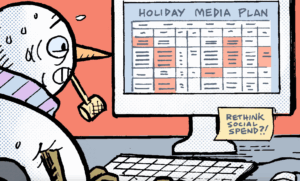 “The Sell Sider” is a column written by the sell side of the digital media community.
“The Sell Sider” is a column written by the sell side of the digital media community.
Today’s column is written by Rachel Parkin, senior vice president of strategy and sales at CafeMedia.
Nearly two years after header bidding exploded onto the programmatic scene, we are seeing a race to embrace the next big thing: server-side header bidding, where ad auctions move from users’ browsers into the server.
But whether server-side header bidding is a solution for the long haul or yet another stepping stone remains to be seen. It will, however, bring about a number of welcome and much-needed changes that will radically alter the programmatic landscape.
Server-side header bidding will play the role of a catalyst. At this point, I see three likely outcomes: consolidated supply-side exchanges, new auction dynamics and improved user experience.
Consolidation Of Supply-Side Exchanges
Server-side header bidding may initially spur publishers to expand the adoption of supply-side platform (SSP) partners, since it sidesteps caps on concurrent bid requests without sacrificing the user experience. This makes it low-cost for publishers to add an unlimited number of SSPs to their auctions, but that’s also where the consolidation begins.
Every one of these SSPs will then fight to be “on the page.” Supply partners in the header will likely have some advantage because of cookie loss associated with server-side implementations and the inherent value of data-rich cookies to buyers.
The “on-page” exchanges will also be the least likely to have their bid time out since they are able to conduct an auction before all of the server-side-connected exchanges. Most publishers will probably end up putting one to three strategic supply partners on the page and all others in the server-side wrapper.
SSPs wanting a coveted page spot will need to offer server-side header bidding at a nominal or no-cost structure with maximal transparency and reporting into all auctions. Server-side header bidding could bring about a secondary wave of innovations, too, as supply partners offer better services, products or pricing structures to become a strategic partner.
That many more bids in the system creates a technological chokehold on both SSPs and demand-side platforms (DSPs) that are already navigating how to manage the number of queries per second today. Only hearty SSPs will be able to invest in handling the new multitude of bid requests required of server-side solutions. DSPs may steer further toward throttling queries per second or cutting back the number of exchanges in their platforms to just those with the most unique or requested inventory. SSPs will have to prove their point of difference or risk being left out.
With more suppliers and fewer slots at the table, the market is poised for a contraction. Some exchanges will be acquired. Many will go out of business. Some may change their business model and become “auction-only” exchanges without direct publisher connections. And a few will emerge as the leading server-side header bidding aggregators for bids and cookies.
New Auction Dynamics
The proliferation of simultaneous auctions on the same impression via header bidding have started to cripple the efficiency and stability benefits of the second-price mechanism.
Already three series of auctions occur in the process: internal DSP auctions, SSP auctions and the ad server auction. This has created scenarios where the buyer who values the impression the most doesn’t end up winning. As server-side header bidding enables more SSPs to conduct parallel auctions, the inefficiencies of a three-tiered auction will be amplified.
Server-side header bidding makes it possible to create a fully unified second-price auction in theory, yet it requires a lot of trust on the part of all auction participants. A more transparent unified auction will help allay concerns about hidden fees and gaming on the SSP side as it encourages all SSPs to submit their truthful bid. Since not every server-side solution will run a unified auction, publishers and advertisers will need to advocate for shared bid data among all aggregators and auctioneers to make this a reality.
Many have also called for a move to a first-price auction as it ensures the highest bidder always wins, regardless of the number of mediation layers. To the extent that publishers are introducing dynamic floors into a second-price auction today, it encourages first-price bidding anyway. However, all parties will need to know that first-price is the auction mechanism to bid appropriately.
Server-side solutions will be the domino that finally moves buyers and sellers toward a new auction paradigm. Irrespective of the final path, the need for more transparency is evident. Its arrival will work to reduce hidden ad tech fees and put more of an advertiser’s dollars toward working media.
A Focus On The Full User Experience
Removing auction latency from the equation with server-side header bidding brings focus back to the ads, which often take as much time to load as it does to run the auction.
In a server-side world, buyers will need to be as accountable as sellers in minimizing the impact of advertising on the user experience. Alignment and enforcement around a set of ad load standards, such as the IAB LEAN Ads Program, is critical to set the best experience for users and maintain a healthy internet advertising market.
Measurement has been crucial to shifting more advertising into programmatic, but it’s also to blame for feeding the latency juggernaut. For every ad, most advertisers apply a suite of pixels to track viewability, nonhuman traffic, brand safety, brand lift and sales lift, among others.
Since publishers want visibility into performance, they also apply additional pixels to capture many of the same metrics. DSPs and SSPs also pile more pixels on top for insight into their respective marketplaces. Buyers and sellers will need to welcome data sharing and open-source measurement to keep consumers from blocking ads.
The speed of server-side header bidding auctions will actually shift attention to the impact of ads on page load times and make advertisers equal partners in creating a better user experience.
Follow CafeMedia (@CafeMedia) and AdExchanger (@adexchanger) on Twitter.













